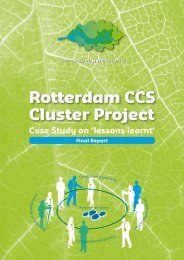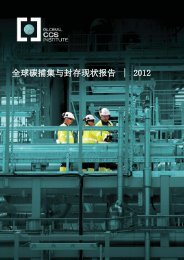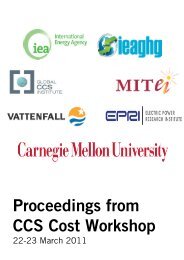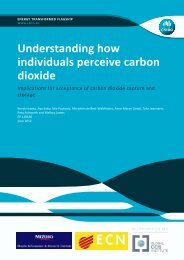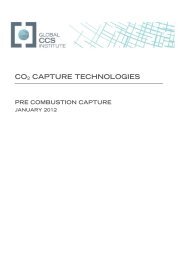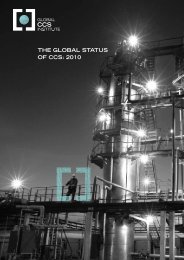FINAL REPORT ON PROJECT PIONEER - Global CCS Institute
FINAL REPORT ON PROJECT PIONEER - Global CCS Institute
FINAL REPORT ON PROJECT PIONEER - Global CCS Institute
You also want an ePaper? Increase the reach of your titles
YUMPU automatically turns print PDFs into web optimized ePapers that Google loves.
<strong>PROJECT</strong>PI<strong>ON</strong>EER<strong>FINAL</strong> <strong>REPORT</strong> <strong>ON</strong> <strong>PROJECT</strong> PI<strong>ON</strong>EER20131
DISCLAIMERThis report was prepared by using the bestavailable information. Neither TransAltaCorporation, Capital Power L.P. and Enbridge Inc,or any of their employees or contractors, makesany warranty, express or implied, or assumesany legal liability or responsibility for the accuracy,completeness, or usefulness of any information,apparatus, product, or process disclosed,or represents that its use would not infringeprivately owned rights.TransAlta, on behalf of itself and its affiliates,directors, officers, employees, contractors,consultants, agents or others for whom TransAltais responsible at law, completely disclaims any andall liability arising from any use of the information,including liability for any losses, damages, lawsuits,claims or expenses, consequential losses.Reference to any specific commercial product,process, or service by trade name, trademark,manufacturer, or otherwise does not necessarilyconstitute or imply its endorsement,recommendation, or favouring by TransAltaCorporation, Capital Power L.P. and Enbridge Inc.The Information is proprietary and may not bereproduced without the express written consentof TransAlta.© TransAlta Corporation, 2013i
IMPORTANT NOTE REGARDING<strong>PROJECT</strong> PI<strong>ON</strong>EER – APRIL 2012On April 26, 2012, TransAlta, along with partnersCapital Power and Enbridge, announced thedecision not to proceed with the carbon captureand storage (<strong>CCS</strong>) project called Project Pioneer.The Pioneer partners concluded that thetechnology works and that capital costs were inline with expectations. However, the market forCO 2 sales and the value of emissions reductionsin Alberta and Canada are not sufficient, at thistime, to allow the project to proceed.While it is disappointing to be unable to achievethe result hoped for, it is important to rememberthat the purpose of Project Pioneer was to ‘proveout’ the technical and economic feasibility of <strong>CCS</strong>before going down the major capital investmentpath. That purpose was achieved: the two yearsof hard work by the Project Pioneer team wasa major success.The Pioneer partners come out of this with amuch deeper understanding of <strong>CCS</strong> in an Albertasetting. And of course, it is the intention to sharethis understanding with the federal and provincialgovernments and the global scientific communityso others can benefit from what was learned.ABSTRACTThe safe storage of CO 2 can be a vital part ofthe solution to the challenge of global climatechange. Project Pioneer (also referred to asPioneer or Project) was a joint effort by TransAltaCorporation, Capital Power L.P., Enbridge Inc.,the Governments of Alberta and Canada, andthe <strong>Global</strong> <strong>CCS</strong> <strong>Institute</strong> to demonstrate thecommercial-scale viability of carbon captureand storage (<strong>CCS</strong>) technology retrofitted ontoa modern coal-fired power plant.The Project was to be one of the largest and mostadvanced <strong>CCS</strong> projects in the world, and had theleadership and partnership expertise to make theProject – and Canada – a global leader in <strong>CCS</strong>.After completion of a feasibility study and despitesubstantial government and industry investment,the Project was not economically feasible dueto insufficient CO 2 sales markets and emissionspricing in Alberta and Canada. The project wascancelled in April 2012 and will continue to serveas a prototype and information source for thecommercial-scale application and integrationof <strong>CCS</strong> technology.This decision isn’t a reflection on the long-termviability of <strong>CCS</strong> or the future of coal-firedgeneration. Coal is a critical fuel for powergeneration in Alberta and world-wide, andTransAlta believes it will continue to be avital part of the global fuel mix.TransAlta, Project Lead, Project Pioneerii
fig. 1.0KEEPHILLS 3 PLANT1.0INTRODUCTI<strong>ON</strong> TO THE <strong>PROJECT</strong>Project Pioneer would have been one of the firstcarbon capture and storage (<strong>CCS</strong>) projects toutilize an integrated approach for <strong>CCS</strong>, and wasexpected to serve as a prototype for the long-term,commercial-scale application and integration of<strong>CCS</strong> technologies to achieve reductions ingreenhouse gas emissions. The partners in ProjectPioneer were TransAlta Corporation (TransAlta),Capital Power L.P. (CPLP), Enbridge Inc.(Enbridge), the Alberta provincial and Canadianfederal governments, and the <strong>Global</strong> <strong>CCS</strong> <strong>Institute</strong>as a Knowledge Sharing Partner.Project Pioneer was being proposed to capture1 million tonnes of carbon dioxide (CO 2 ) annuallyfrom a coal fired power plant and to transport theCO 2 by pipeline to a sequestration site or to beutilized for enhanced oil recovery (EOR) in adepleted oil/gas field.The key components of Project Pioneer were:• Carbon capture facility (CCF)• Pipeline from the CCF to thesequestration site• Pipeline from the CCF to the EOR site• Saline formation sequestration siteiii
The Carbon Capture Facility (CCF) portion ofProject Pioneer was to have been retrofitted ontothe Keephills 3 coal-fired power plant. Keephills 3is located approximately 70 km west of Edmonton,Alberta and is jointly owned by TransAlta andCapital Power.fig. 2.0The CCF would have treated approximately onethird of the flue gas from Keephills 3 and wouldhave captured approximately 1 million tonnesof CO 2 annually. The CO 2 would have beencompressed and transported by pipeline to asequestration site to be injected approximately2 km underground into a saline formation known asthe Nisku Formation. A pipeline was going to havebeen built also to transport the CO 2 to the primaryEOR target, the Pembina oilfield, where the CO 2would have been injected and used for EOR. ThePembina oilfield is approximately 80 km southwestof the Keephills 3 facility.CARB<strong>ON</strong> STORAGE ILLUSTRATI<strong>ON</strong>iv
Table ofContentsDisclaimeri5.0 Commercial Agreements 14Important Note RegardingProject Pioneer – April 2012Abstract1.0 Introduction to the Project iii2.0 Executive Summary 1Project Purpose 1Pioneer Partners 1Project Description 1Lessons Learned During Initial Phase 23.0 Motivation for Project Pioneer 44.0 General Description of Pioneer 5Carbon Capture Facilityand Keephills 3 5Amine Scrubbing Process 6Pipeline Transportation 8Sequestration Site 10Pioneer Storage Complex 10Geological Assessment Program 12iiiiStrategic Industry Partners 14Funding Partners 14Governments of Alberta and Canada 14<strong>Global</strong> Carbon Captureand Storage <strong>Institute</strong> 15Technology and Service Suppliers 156.0 Sale of CO 2 to EOR 16Avoided Emissions Value 16K3 Interface 167.0 Regulatory and Permitting 178.0 Stakeholder Consultationand Engagement Strategy 179.0 Knowledge Sharing 1910.0 Risk Analysis 2011.0 Project Economics 22Capital and Operating Costs 22Cost of CO 2 Abatement 2412.0 Conclusion 2413.0 Appendix 26v
2.0EXECUTIVE SUMMARYProject PurposeThe purpose of Project Pioneer was to explorethe feasibility of, and subsequently to constructand operate one of the first industrial scaledemonstration projects of carbon capture andstorage (<strong>CCS</strong>) technology retrofitted onto a moderncoal-fired power plant. As the name indicates, thiswas a pioneering effort, and, although a decisionnot to proceed was made in late April 2012, ProjectPioneer will continue to serve as a prototypeand information source for the commercial-scaleapplication and integration of <strong>CCS</strong> technology.Project Pioneer was guided by the followingstrategic drivers:• Demonstrating a viable technology option fornear-zero emissions from coal-fired electricity;• Developing an understanding of the economicviability of <strong>CCS</strong>;• Implementing a solution to present daygreenhouse gas (GHG) emissions and forthe existing coal fleet; and• Addressing environmental policy uncertaintyand related capital decision makingchallenges.Pioneer PartnersPioneer was developed under the leadership ofTransAlta Corporation (TransAlta), with strategicindustry partners Capital Power L.P. (CapitalPower) and Enbridge Inc. (Enbridge). Financialsupport was provided by the Governments ofAlberta and Canada, and from the <strong>Global</strong> <strong>CCS</strong><strong>Institute</strong> of Australia. Pioneer was a uniquecollaboration with varying tiers of involvement;from strategic industry partners, to governmentfunding partners, to service providers and acustomer intending to purchase carbon dioxide(CO 2 ) under long-term commercial arrangements.Project DescriptionProject Pioneer was to capture one million tonnesof CO 2 annually from the Keephills 3 coal-firedpower plant, located in Alberta, Canada. Thecaptured CO 2 was to be transported by pipeline asa dense-phase fluid to a regional oilfield for use inenhanced oil recovery (EOR) and also to a localsequestration site for deep geological storage.Project Pioneer was designed to retrofit <strong>CCS</strong> on anoperating power plant, as opposed to incorporatingit into the design and construction of a new powerplant. Modifications to the power plant were notexpected to be extensive and it was hoped that thisretrofit approach would become applicable to anycoal-fired power plant, thereby providing a practicalway to significantly reduce CO 2 emissions from theexisting coal fleet.The Carbon Capture Facility (CCF) would havediverted approximately one-third of the flue gasemitted by Keephills 3 and treated it to remove CO 2before release to the atmosphere. The CO 2 designannual capture quantity was a nominal 1 milliontonnes but the CCF was in fact designed for aninstantaneous capacity of 1.17 million tonnes peryear (134 tonnes per hour) to take into account theKeephills 3 and CCF availability factors. 90% of theCO 2 present in the flue gas was to be removed.The technology chosen for the CCF was aminescrubbing, which is a widely practiced chemicalprocess. Project Pioneer was to demonstrate theapplicability of amine absorption to coal-fired powerplants, which would have been a new applicationfor the process at this scale. Specifically, theKM CDR Process ® of Mitsubishi Heavy Industrieswas selected.1
The Pioneer pipeline system would havetransported CO 2 from the Keephills site CCF tothe EOR oilfield (74 km) and the sequestration site(8 km). In order to provide maximum operationalflexibility each pipeline leg was designed to beable to accept 100% of the instantaneous CCFCO 2 output. Both legs were designed to the sametechnical specifications. It was expected that duringthe commissioning period and occasionally duringpossible process upsets, all of the CCF volumewould be sent to sequestration to avoid shippingoff-specification CO 2 to the EOR customer. It wasdesired that most of the CO 2 be destined for EORbecause of the positive economic impact of CO 2sales on Project economics.The EOR site was the Pembina oilfield, located70 to 80 km southwest of Keephills 3. ThePembina oilfield was selected due to its proximityto Keephills and also because oil companiesoperating the field were interested in CO 2 EOR butlacked a large volume CO 2 supply. In addition, thepipeline would not be required to cross any majorriver, thus minimizing construction complexity andenvironmental disturbance. Project Pioneer did notto include EOR operations in its scope but engagedin negotiating a long-term CO 2 supply andpurchase agreement with one of the operatingcompanies in the Pembina oilfield.The sequestration site was designed to permitthe instantaneous injection of CO 2 at a rate of1.17 million tons per year (134 tonnes per hour)into the 1,800 meter deep Nisku geologicalformation. It was expected that most of thecaptured CO 2 would be directed to EOR.Therefore, the planning basis was thesequestration, by intermittent injection, of upto 1 million tonnes of CO 2 over 10 years, withmost of the injection occurring in the first severalyears. The sequestration scope included theassociated measurement, monitoring andverification (MMV) plan to quantify injectionvolumes, confirm geological containment, anddetect any potential leaks to ensure utmost safety.Lessons Learned DuringInitial PhaseWork undertaken by the Pioneer team duringthe Initial Phase was intended to inform a LimitedNotice to Proceed investment decision by thePioneer industry partners. This work includedFront End Engineering and Design (FEED) studiesfor the CCF, pipelines and sequestration facility,drilling and testing of one injection well, commercialdevelopment activities, regulatory and permittingactivities, and economic and risk analysis.Following the conclusion of the Initial Phasestudies, the industry partners determined thatalthough technology, engineering designs,operational processes, and capital costs werein-line with expectations, markets for CO 2 salesand the price of emissions reductions wereinsufficient to allow the Project to proceed. TheProject will continue to serve as a prototype andinformation source for the commercial-scaleapplication and integration of <strong>CCS</strong> technology.Pioneer resulted in a much deeper understandingof <strong>CCS</strong> that is being shared, so others can benefitfrom these learnings. The following are lessonslearned in each area of the Project.The policy framework will need to provide moresupport for the development of markets for CO 2sales and more certainty about the value of GHGemissions reduction credits in order for commercial<strong>CCS</strong> projects to have sufficient assurances aboutfuture revenues.The cost of <strong>CCS</strong>, although in-line withexpectations, was found to be relatively high.Approximately three-quarters of costs wereassociated with carbon capture and decisionsabout the CCF were the main drivers of costsand financial risk for the Project.Government funding remains necessary for earlydemonstration <strong>CCS</strong> Projects. However, the publicfunding mechanisms used to support Pioneer werefound to be challenging owing to their complexity.2
Market demand for CO 2 continues to be uncertain.The size of this market is highly dependent onrapidly changing oil and gas technologies. Themarket price of CO 2 is also uncertain and thereremains limited visibility and certainty about thepresent and future value of CO 2 emissions credits.Amine scrubbing technology was determinedto be the technology most mature and closestto commercialization from a technical standpoint.Project Pioneer concluded that it was technicallyand operationally feasible to retrofit aminescrubbing technology on a coal-fired power plant.Design was optimized by considering the CCF asa standalone CO 2 production unit and not as apower plant compliance unit, and by adoptingreliability practices from the chemical industryrather than from the power industry. Productionof steam and power by a standalone cogenerationunit simplified the interface with the host powerplant and reduced overall cost. Deep and earlyinvolvement of the power plant owners made fora win-win situation.The pipeline system was a relativelystraightforward matter due to the fact thatstandards, specifications and indeed operatingpipelines exist for CO 2 transportation.The design of the sequestration facilities and ofthe MMV program was informed at the early stageby preliminary studies but hampered by a paucityof well control information. In order to validate theconclusions of the preliminary studies it was foundto be imperative to drill an evaluation well and tosecure as much information as possible from it.The MMV program must be designed rigorously,starting from a full risk assessment, and includea complete baseline characterization and suiteof monitoring and mitigation measures.The regulatory consultation, application andpermitting process was determined to haveperformed more or less as anticipated. Certainregulatory gaps did exist relative to <strong>CCS</strong> butgovernment was making efforts to fill them albeitin a timeframe that was challenging for Pioneer.Project complexity made risk management anextremely challenging task. Complexity arose fromthe large number and wide diversity of partners andstakeholders and the newness of <strong>CCS</strong> in general.Stakeholder engagement went above what isrequired by regulation. It nurtured existingrelationships while developing new connectionswith stakeholders. Coordinated outreach strategiesare required to communicate evolving technicalinformation in a consistent and timely fashion asprojects develop.Knowledge sharing was integral to the Project.A dedicated knowledge sharing specialist ensuredthat networks and relations were developed withother organizations and projects. The developmentof a knowledge transfer network was a valuableaccomplishment of Pioneer, as it provided theProject team with information and learnings fromother Projects and thus avoided costs and sped upthe Pioneer learning curve.When the Project partnership includes membersfrom different industries, expectations for risktolerance and financial returns need to be aligned.Transparency and a willingness to shareinformation with partners and with public sectorfunders were necessary to allow the Project toadvance smoothly. Project leadership needed tobe flexible, adaptive and innovative because thereare few precedents and little industry and companyexperience with commercial <strong>CCS</strong> projects. ProjectPioneer evolved constantly and several elementsunderwent significant changes in order to respondto emerging challenges.3
fig. 3.0AMINE SCRUBBING PROCESS7
Pipeline TransportationThe Pioneer design included the transportationof the captured, dehydrated and compressed CO 2800 meters from the Keephills 3 plant site to theCO 2 metering station at the head of the pipelinelegs to the EOR oilfield and the sequestration site.In order to provide maximum operational flexibility,each pipeline leg was designed to be able toaccept 100% of the instantaneous CCF CO 2output.The pipeline diameter selected was NPS 10(nominal pipe size of 10 inches or 273.1 mmoutside diameter). The pipeline was designedto accept 99.5% pure dense-phase CO 2compressed to 14 MPa. A metering stationwas to be constructed at the oilfield receivingterminal where product custody would have beentransferred to the oil producer. CO 2 is an acidgas that will react with water to form carbonicacid which will cause corrosion challenges.Thus, it is crucial that CO 2 accepted for pipelinetransportation meet stringent quality specification,particularly for contamination by water. Properdehydration of the CO 2 stream is important in orderto avoid the critical dew point temperature that maybe encountered due to line shut-in or exposed pipein contact with ambient temperature conditions.The Pioneer CO 2 specification for water contentwas maximum 50 ppmv (parts per million byvolume).While CO 2 is non-toxic, at high enoughconcentrations it can be an asphyxiant and amajor CO 2 release could potentially have seriousconsequences. The design of the CO 2 pipelinesmust reflect the potential risks involved, particularlyblock-valve spacing.Several pipeline routing alternatives for the EORpipeline were considered based on environmental,social, economic, and geotechnical analysis.Although shorter routes were technically feasible,the selected route utilized existing right-of-way(ROW) for about one quarter of its length, and wasdetermined to be more acceptable to landownersand local communities. The selected pipeline routewas 74 km long and crossed minor waterways andthree highways. The largest urban area close to thepipeline route was the Town of Drayton Valleylocated 5.6 km east of the pipeline.The pipeline to the sequestration site was designedto the same technical characteristics as the EORpipeline because it was also designed to becapable of handling the same CO 2 volumetric rate,which is 100% of the CCF output. As with the EORpipeline, the sequestration pipeline would haveoriginated from the Keephills CO 2 metering station.The sequestration pipeline was to be approximately6 to 8 km long and was to terminate at a meteringstation located at the sequestration site, which wasto be located to the southeast of the Keephills site.The routing utilized existing ROW for 80% of itslength.The two pipeline routes are shown in Figure 4.8
fig. 4.0PIPELINE ROUTES9
Sequestration SiteIn <strong>CCS</strong>, CO 2 is captured and then utilized in oneof two ways: for EOR or for sequestration. Thedominant CO 2 approach in the medium to longterm is expected to be sequestration, which is theinjection of CO 2 into characterized and appropriategeological formations deep below the surface.EOR is only applicable where suitable oil reservoirsare present, and only for the limited time requiredto recover additional oil from the reservoir.Sequestration, on the other hand, is possibleanywhere appropriate deep saline formations exist,which are geological formations far more prevalentand extensive than oil reservoirs.The basics of geologic storage are known andit is practiced in specific and limited industrialsituations, such as for acid gas disposition.The deployment of sequestration to mitigateclimate change will however, require large scaleimplementation, the scale of which will be oneor two orders of magnitude larger than existingindustrial practice. Furthermore, it will mean thatpotential future sequestration locations might becloser to population centres than the few projectscurrently in operation.Project Pioneer was to be one of the world’slargest <strong>CCS</strong> implementations, serving to provethe technology, precisely quantifying its costsand demonstrating its safety and viability.The sequestration site was designed to permitthe instantaneous injection of CO 2 at a rateof 1.17 million tons per year (134 tonnes per hour)into the 1,800 m deep Nisku geological formation.In other words, the sequestration infrastructure andstorage complex was to be able to accept the fulloutput of the CCF. However, it was expected thatmost of the captured CO 2 would be directed toEOR. Therefore, the planning basis was thesequestration by intermittent injection of up to1 million tonnes of CO 2 over 10 years, with mostof the injection occurring in the first several years.Although injection was to be intermittent, thesystem was designed to always be available,subject to a reasonable ramp-up time.Pioneer Storage ComplexSeveral past studies, including the AlbertaSaline Aquifer Project (ASAP) and the WabamunArea Storage Project (WASP), had identifiedthe 1,800 meter deep Nisku Formation in theWabamun Lake area as a prospective reservoirfor large-scale geologic sequestration of CO 2in a saline formation. The Nisku formation isan intermittently porous and tight dolomitizedcarbonate formation. It does not have majorhydrocarbon production in the area and is thedeepest stratigraphic unit with relatively extensivereservoir quality. The Winterburn storage complex,as defined by the Project, includes the Ireton,Nisku, Calmar, Blue Ridge, Graminia, Wabamun,and Exshaw formations. Underlying the Niskuformation is the Ireton formation, which is aregional shale that forms the bottom seal of theWinterburn storage complex. The interbeddedshales and carbonates of the Calmar, Blue Ridge,and Graminia formations form the upper portionof the Winterburn Group and were expected toact as a primary seal for CO 2 injection into theNisku Formation. The Exshaw formation overliesthe Wabamun Group and is a regional sealingshale able to serve as a secondary seal above theprimary seal. Figure 5 provides an overview of thestratigraphic column in the Wabamun Lake area.10
fig. 5.0STRATIGRAPHIC COLUMN IN THE WABAMUN LAKE AREA11
Geological Assessment ProgramA full CO 2 Storage Evaluation Program wasundertaken and used to develop the scope ofsequestration activities during the course of the10-year injection period and a second 10-yearclosure period. The purpose of the StorageEvaluation Program was to evaluate the validityof potential geologic sequestration of CO 2 inthe Winterburn Storage Complex. Despite thecompletion of several other studies indicatingthat the Nisku formation in the Wabamun Lakearea was likely suitable for large-scale geologicsequestration of CO 2 , sufficient information tosupport regulatory approvals for a CO 2 storagescheme and a well-founded investment decisiondid not yet exist. The Program provided thenecessary information to support both internaland regulatory decisions regarding the ProjectPioneer CO 2 sequestration scheme.The Program involved evaluating the ability of theWinterburn storage complex in an area near theKeephills facility to provide sufficient injectivity,capacity, and containment to inject over a 10-yearperiod and permanently store up to 1 million tonnesof CO 2 . The Program included the drilling andtesting of one evaluation well, associated seismicacquisition, evaluating the integrity of existing wellsin the Project area, and baseline environmentalmeasurements. Water injection testing wascompleted in the evaluation well, but no CO 2injection tests were undertaken. A baseline threedimensional(3D) seismic survey was planned butnot initiated by the time of Project cancellation.The evaluation well resulted in the acquisition of alarge volume of high quality geological information:• 45 m of caprock and reservoir core;• Reservoir fluid samples;• State of the art wireline logs; and• Injection test.Photographs of core from the Nisku and Calmarformations are shown in Figure 6. The Niskuformation appears porous and vugular while theoverlying Calmar seal is tight. Data was used toupdate the numerical geological model and supportthe development of a reservoir model to analyzeCO 2 injection and plume development scenarios.12
6.0fig.PHOTOS OF CORES FROM THE EVALUATI<strong>ON</strong> WELLNisku FormationCalmar FormationThe overall conclusion of the evaluation well program was the confirmation of very good storage formation andgood caprock at the selected location. The evaluation well was determined to be capable of accepting the totalProject Pioneer instantaneous injection rate of 1.17 million tonnes of CO 2 per year.13
5.0COMMERCIAL ARRANGEMENTSProject Pioneer was a unique collaborationbetween TransAlta, Capital Power and Enbridge,the Governments of Canada and Alberta, the<strong>Global</strong> <strong>CCS</strong> <strong>Institute</strong>, key suppliers of goods andservices and an EOR customer aimed at buildingand operating a fully-integrated <strong>CCS</strong> project in thepower sector.Strategic Industry PartnersTransAlta, Capital Power and Enbridge were thestrategic industry partners. They provided theoverall direction for the Project, brought theirrespective expertise and, as equal owners,financial investment.Partner selection was done by TransAlta. As abasic tenet of the consortium approach takenby Pioneer, all strategic industry partners hadto participate as equity partners with an equalshare across all elements of the project –capture, transportation and storage.The main partner selection criteria were anunderlying strategic interest in <strong>CCS</strong>, skillsetscomplementary to the Project, balance sheetstrength (as no project financing was used) andrisk management ability. Risk sharing betweenpartners of the various Project risks that alignedwith the government funding requirements waskey. Strong relationships based on previousexperience with Capital Power and Enbridge,as well as similar risk/return profiles, made themideal candidates as industry partners.Project Pioneer brought together industry partnerswho had been leaders in power generation, energydelivery and environmental issues for years.TransAlta was the project leader, and broughtextensive experience in power generation,construction and innovation to the Project. Thecompany provided technical, commercial andproject management to Pioneer. Capital Powerwas the generation partner and brought best-inclasspower technology. Capital Power shares along history with TransAlta and is the joint venturepartner with TransAlta in Keephills 3. Enbridge wasthe transportation partner, bringing its pipelineexpertise as a North American leader in energydelivery.Funding PartnersGovernments of Alberta and CanadaBoth the Alberta and Canadian governments werekey funding partners in Pioneer. Governmentfunding was integral to the Project, as substantialfunds were required to produce a business caseacceptable to the industry partners. Funding wasgranted by government in order to advance <strong>CCS</strong>technology and to promote knowledge sharing. TheProject was awarded approximately $779 millionin funding commitments from the Governmentsof Canada and Alberta. This included $27 millionthrough the federal EcoENERGY TechnologyInitiative (ETI) and $315.8 million from theClean Energy Fund (CEF), both of which areadministered by Natural Resources Canada(NRCan), and $436 million from the Provinceof Alberta. Provincially, the majority of fundingwas committed by Alberta Energy through the<strong>CCS</strong> Fund in the amount of $431 million, withan additional $5 million contribution from AlbertaEnvironment’s EcoTrust Grant to support FEEDand development work.14
The structure and nature of government fundingdrove many business decisions and added anadditional layer of complexity to the Project thatrequired strategic management of timelines andgoals. Continuing funding requirements were manyand included the meeting of Project milestonesas well as specified operating targets, principallyreduction of at least 10 million tonnes of CO 2 afterten years of operation. Project economic returnsto industry partners were capped throughmechanisms in both the CEF and <strong>CCS</strong> fundingagreements. Importantly, these agreements alsorequired the repayment of funding if the Project didnot meet certain minimum performance thresholds.At the time of project cancellation, only a smallfraction of the Project budget had been spent byindustry and governments to fund the Initial Phasestudies.<strong>Global</strong> Carbon Capture and Storage <strong>Institute</strong>The <strong>Global</strong> <strong>CCS</strong> <strong>Institute</strong> (G<strong>CCS</strong>I) acts as anindustry/government partnership and provided$5 million AUD to promote knowledge sharingduring the Initial Phase of the Project, and thusserved as the knowledge sharing partner. TheG<strong>CCS</strong>I accelerates the adoption of <strong>CCS</strong>, akey solution in mitigating climate change andproviding energy security. The <strong>Institute</strong> facilitatedconversations between Project Pioneer and other<strong>CCS</strong> projects and subject matter experts. Theorganization’s commitment was used to supportProject Pioneer and specifically the activities duringthe Initial Phase FEED and development work.Technology and Service SuppliersMany suppliers brought exceptional expertise andenthusiasm to the unique challenges presented bythe nature of a project without precedent in Alberta.They included:• Mitsubishi Heavy Industries America. Turnkeysupplier of the 1 million tonnes per year CCFusing its proprietary amines-based capturetechnology.• Enbridge. In addition to being a strategicindustry partner, Enbridge providedpipeline design and engineering and wouldhave provided permitting, procurement,construction, commissioning and operationof the complete pipeline system.• Schlumberger Carbon Services. Responsiblefor the design, permitting, procurement,construction, commissioning of all wells andfor the performance of the sequestration field.Essentially, Schlumberger was responsiblefor all downhole work terminating at eachwell valve. This included all MMV activitiesrequired by the regulator.• Golder Associates. Provided consultingservices related to environmental matters,particularly in relation to the acquisitionof permits.• Alberta Innovates – Technology Futures.Provided advice and support to the designof the MMV Program.• Stantec Consulting. Acted as Owner’sEngineer, providing oversight and advicerelative to the CCF.• Communica Public Affairs. Developed andcoordinated public consultation programsin concert with the industry partners’internal experts.• Ipsos Reid. Provided public opinion pollingservices.• Individual expert consultants.15
6.0SALE OF CO 2 TO EORPioneer would not have had stake (planning,permitting, ownership or operation) in any aspectof the EOR field, nor would EOR customers haveownership or operational responsibilities for theCCF, the pipelines or the sequestration field.The EOR element added a key revenue stream tothe Project by virtue of selling the CO 2 product tothe EOR customer and the generation of emissionreduction instruments for CO 2 sequestered at theEOR site. Pioneer was to derive benefit from allemissions reduction instruments generated whichmeant that the value of these instruments wouldremain constant for Pioneer whether carbonwas sequestered on-site or whether CO 2 wassequestered through its use in EOR.The Project expected sales of up to 1 milliontonnes/year of CO 2 beginning in late 2015 to theEOR customer, generating revenues expectedto be in the range of $300 million over a 10 yearoperating period.An arrangement, likely in the form of governmentregulation that would enable the monetizationof avoided emissions instruments created byPioneer was required for the Project to proceed.This proved to be most challenging as publicpolicy decisions require careful deliberation bygovernment and the timeline for decision makingdid not align well with other timelines for theProject mandated within the funding agreements.K3 InterfaceA degree of complexity surrounded the interfaceof Pioneer with Keephills 3, in some measure duethe differing ownership of the two facilities. Pioneerhad adopted a “no-harm, no benefit” approachregarding the Keephills 3 facility. Of particularnote was the question of the long term effect ofusing steam from Keephills 3 for Pioneer’s captureprocess and any liability associated with potentialdamage to Keephills 3. Given the range ofexpected future natural gas prices, the useof cogeneration for the production of steam atPioneer was a cost-neutral option. As such, thedecision to use internal cogeneration for Pioneerrather than using Keephills 3 as a steam sourcewas made and greatly simplified this interfaceissue.Avoided Emissions ValueThe economics of the Project were developedwithin an expectation of a carbon cap and tradesystem for Canada which would have allowedthe creation of immediate value from emissionreductions achieved by <strong>CCS</strong> prototype projects.That value stream would have been monetizedas either emission reduction instruments or asavoided compliance costs. In either situation,this anticipated value stream was estimated tobe in the range of $300 million over the courseof the Project. Regulatory uncertainty over thevaluing of emissions reductions associated with<strong>CCS</strong> complicated the Project.16
7.08.0REGULATORY AND PERMITTINGThe regulatory consultation, application andpermitting process for the Project was progressingas anticipated at the point of Project cancellation.The scope of the environmental assessment wasdefined in large part by NRCan’s determinationthat the Project was subject to a screening levelassessment and the Province’s decision not torequest the completion of an Environmental ImpactAssessment. Provincial regulatory permittingrequirements were also as expected, though therewas some uncertainty surrounding Alberta UtilitiesCommission application requirements given CCFdesign modifications which resulted in no energypenalty for Keephills 3 and no grid connection forthe power generating unit. The general impressionfrom the provincial and federal regulators was thatthe permitting schedule was achievable.STAKEHOLDER C<strong>ON</strong>SULTATI<strong>ON</strong>AND ENGAGEMENT STRATEGYCarbon Capture and Storage is an emergingtechnology and, as such, its characteristics,benefits and impact are not widely known. Itwas concluded that the implementation of <strong>CCS</strong>in Alberta would lead to questions and concernsfrom the public, First Nations, neighbouringcommunities, as well as many other stakeholdergroups.It is widely recognized that a comprehensive andsincere consultation and engagement process isrequired for success for any development projectand particularly when novel technology is involved.The Pioneer consultation and engagementprocess was critically important. It often was themechanism through which stakeholders first heardand learned about <strong>CCS</strong>. It was also an importantbuilding block toward achieving success andobtaining the ‘social licence’ to proceed withthe Project.Extensive efforts were made to involve allstakeholders. Figure 7 provides a recap of theconsultation activities.17
fig. 7.0C<strong>ON</strong>SULTATI<strong>ON</strong> AND ENGAGEMENT ACTIVITIES BY STAKEHOLDER GROUP18
9.0KNOWLEDGE SHARINGKnowledge generated by the Project was of globalinterest, particularly with respect to technicalfindings, the identification and managementof risks in such projects, the developmentand acceleration of regulatory frameworks for<strong>CCS</strong>, and the understanding of the economicsassociated with large commercial-scale <strong>CCS</strong>projects. Those involved in the Project recognizedthat global knowledge transference amongst<strong>CCS</strong> projects would help in addressing commonchallenges and allow for successes to be repeated.Knowledge sharing had mutual value for theProject, as it was bidirectional: Project partnerslearned through incoming knowledge from othersources, as well as being able to share outgoingknowledge with others, including other <strong>CCS</strong>projects and academics. The Project’s leadershipfelt quite strongly that there was a direct linkbetween what and how much the Project shared,and what and how much knowledge was received,in return.Knowledge transfer was facilitated by theopenness of participants involved in <strong>CCS</strong> ingeneral and in Pioneer in particular, driven by theconsortium philosophy and expectations from thepartners that knowledge and experience generatedby such emerging and prototype projects wouldaccelerate the development of <strong>CCS</strong> as well aspotentially drive down costs of such projects.Significant collaboration occurred and continuesto occur amongst Canadian projects andorganizations, as well as global collaborations.Other projects which developed similar roles wereLongannet Power Plant in Fife, UK, led by ScottishPower, as well as the Alberta Carbon Trunk Linebeing planned by Canada’s Enhance Energy, andthe Shell Quest project in northern Alberta.Project Pioneer’s Knowledge Transfer Specialistworked to build knowledge and relationshipswith <strong>CCS</strong> proponents both globally and locally,including with the G<strong>CCS</strong>I in Australia and withAlberta Energy and Natural Resources Canada.The role was an important part of establishingconnections and facilitating some key relationshipsfor the Project, as well as acting as a designatedpoint of contact for information exchanges.19
10.0RISK ANALYSIS<strong>CCS</strong> projects could be considered a special typeof oil and gas capital projects. On the one hand,the standard approach used for risk managementof oil and gas capital projects is applicable to <strong>CCS</strong>projects. On the other hand, the uniqueness of<strong>CCS</strong> projects as well as the characteristics of aparticular project should influence the design ofthe Risk Management System (RMS).The uniqueness of <strong>CCS</strong> projects is reflected in thefollowing points:• <strong>CCS</strong> integrates several subprojects thatare different in nature: carbon capture,transportation, and sequestration. Thecomplexity of interfaces between thesubprojects and between the engineering,procurement and construction work packagescreates multiple additional risks.• The technologies used in <strong>CCS</strong> cannot yet beconsidered fully proven despite the existenceof several working <strong>CCS</strong> pilots and projects.One of the reasons for this situation is thatthere is no standard configuration for <strong>CCS</strong>projects. A variety of technologies areavailable to be used for carbon capture,transportation and sequestration. The level ofmaturity of some of them is low, especially inthe area of carbon capture and sequestration.This creates the possibility of the existenceof unknown risks.• The commercial model for CO 2 marketing isnot mature. The absence of supply gives riseto the lack of demand and vice versa. Thisvicious cycle has yet to be broken. Focusedand coordinated efforts are required fromindustry and governments to resolve thisstalemate.• The economic viability of <strong>CCS</strong> projects isheavily dependent on realizing a financialbenefit from the emissions reductions created.A broad regulatory framework does not existto create emissions reduction instruments(credits) from <strong>CCS</strong> nor does a liquid carbonmarket to provide a mechanism to monetizethem.The challenges facing <strong>CCS</strong> projects were driversbehind programs by the Governments of Canadaand Alberta to support several <strong>CCS</strong> projects andto provide funding for their development. ProjectPioneer was one of them. In addition to the general<strong>CCS</strong> challenges, the following characteristics ofProject Pioneer added to Project complexity:• The Project included participation andcontributions from TransAlta, CapitalPower, Enbridge, the Federal and AlbertaGovernments and the <strong>Global</strong> <strong>CCS</strong> <strong>Institute</strong>.The large number of partners madestakeholder management one of thesources of risks.• The Federal and Alberta Governmentswore two hats as related to the Project:funding partners and regulators. In the formercapacity, governments worked to accelerateproject development albeit introducing anadded layer of complexity with the fundingrules. In the latter role, however, governmentsbecame a potential source of delays andcomplications regarding the permittingprocess and the promulgation of <strong>CCS</strong>regulations.• The CCF was to be retrofitted to the existingKeephills 3 coal-fired power plant. This typeof brownfield construction approach generallyentails many risks related to physicalinterfaces with existing facilities andrestrictions imposed by power plantoperations.20
• Even when only one type of storage(geological formation vs. oil reservoir)is contemplated, a <strong>CCS</strong> project needs tobe considered complicated. The scope ofProject Pioneer, however, included bothtypes of storage. This increased the overallcomplexity of the Project and gave rise toseveral commercial risks relating to salesof CO 2 for EOR purposes.• Part of the Pioneer scope was to prove theeconomic feasibility of <strong>CCS</strong> through sellingCO 2 to an EOR customer. Despite the factthat there are a large number of Alberta oilreservoirs that are a good fit for miscible orimmiscible CO 2 flooding, the emergence ofnew technologies for oil recovery such ashorizontal drilling and multi stage hydraulicfracturing made CO 2 -based EOR a lessattractive investment opportunity for thepotential EOR customer at the time. Thisbecame a major obstacle for Project Pioneerto overcome.• While regulation of GHG emissions exitsin Alberta under the Specified Gas EmittersRegulation, the value ascribed to emissionsreductions is a maximum of $15/tonne. Thisvalue proved to be too low for Pioneer andit was not clear how additional value couldbe realised, creating a major source ofuncertainty for the Project.• Four major subprojects were to be integratedto form Project Pioneer: the CCF, the pipelinefrom the CCF to sequestration facilities,the pipeline from the CCF to the EOR site,and the sequestration facilities. Projectdevelopment and execution would haverequired robust coordination and interfacemanagement between the several supply,engineering and construction companiesinvolved in the subprojects. This requirementfor coordination inevitably generatescorresponding risks.• The project spans four industries, namelypower, chemical, pipeline and oil and gas.All these industries conceptually treatrisk analysis the same way but there aredifferences in methodology, process, criteriaand priority. Trying to accommodate thisinto one set of risk guidelines and a masterrisk register was a challenge. In addition,corporate risk analysis is confidential, hencecomplete openness and clarity was notpossible in all cases.Both general <strong>CCS</strong> challenges and features specificto Project Pioneer were taken into account whenshaping the Project RMS.21
11.0<strong>PROJECT</strong> EC<strong>ON</strong>OMICSA comprehensive Discounted Cash Flow(DCF) model was developed to understand theeconomics of the Project. Various estimates ofcapital and operating costs as well as of revenueswere key inputs into the model. A modest 10%after-tax unlevered return was targeted.Assumptions for plant commissioning, start-upand ramp up to 1 million tonnes of CO 2 per yearwere built into the model. Accounting was madefor planned and forced outages to the Keephills 3facility as well as for the Pioneer facilities.Scenarios were also created to model variousperformance levels of the CCF. Conservatively,no residual or terminal value was ascribed tothe Project in the economic analysis, as the baseassumption was that that reclamation costs wouldbe equivalent to the scrap value of the assetsif decommissioning occurred.The period of operations was set at 10 years, from2016 to 2025, which was determined largely by theavailability of government operating funding for thistimeframe. Assumptions were made for this periodregarding revenues derived from the sale of CO 2for EOR, realization of value for avoided emissionsinstruments and the receipt of governmentoperating funding. Costs for operating the CCF,pipelines and sequestration facility as well as costsfor items such as general and administrative costs(G&A) and taxes were estimated. In addition, costswere included beyond the 10 years of operationsto account for the subsequent sequestration facility10-year post-closure period from 2026 to 2035.The availability of government funding and theircomplex requirements were important factorsin the economics. Examples of the complexityin government contracts include stacking andmatching tests, profitability tests, annual fundinglimits and the need to reach milestones necessaryfor the disbursement of funds.The Project was anticipated to be in serviceby December 31, 2015. This would have allowedthe Project a full ten years of operating funding,given the termination of the operating componentof provincial <strong>CCS</strong> funding in 2025.A positive Net Present Value of $7.3 millionindicated that the Project was expected to achievean unlevered after tax return slightly above 10%.Given that the government funding had noexpectation of a return of or on its capital, this 10%return is effectively that of the industry partners.Capital and Operating CostsTotal capital costs were estimated to be$668.9 million, including construction of theCCF, the sequestration and EOR pipelines, thesequestration facilities, interest, owners’ costs,contingency, and escalation (Table 1). The majorityof these costs were for construction of the CCF,at $478.5 million (which included $6 million fordebottlenecking post initiation of commercialoperations). Capital cost for the pipeline system,at $80.6 million, was the second greatestcontributor. Owners’ costs were estimated at$77.9 million, mainly comprised of the InitialPhase work (FEED and engineering studies, theevaluation well and development costs) as wellas Execution Phase costs outside the scope of theCCF, pipeline or sequestration contractors. Capitalcosts for sequestration and interest were the least,at $23.0 million and $9.0 million, respectively.22
Total operating costs were estimated at$586.6 million. While gas commodity and transportcosts comprised the largest single portion of theseexpenses, they were exceeded by total operationsand maintenance (O&M) costs, at $239.5 million(Table 1). The maintenance portion of the CCFO&M cost estimate was based on a typicalchemical industry based percentage of the CCFreplacement asset value, with other O&M costs,such as chemicals, consumables and staffing costsspecifically determined. Of the particular sources ofO&M costs, CO 2 capture costs were substantiallygreater than those estimated for the pipelinesystem, sequestration facilities, post-operation,and cogeneration. The final interface designfor Keephills 3 reduced costs for the Project, ascogeneration was a more cost-effective alternativegiven low natural gas prices. Post-operating O&Mwere associated with MMV costs expected to beincurred after the termination of CO 2 injection.table 1.0BREAKDOWN OF ESTIMATED CAPITAL AND OPERATING COSTS FOR 10 YEARSCapital Costs Total (million $)CCF $478.5Pipeline $80.6Sequestration $23.0Owners Costs $77.9Interest During Construction $9.0Total Capital Costs $669.0Operating Costs (10 years operating and 10 years post-closure) Total (million $)Gas Commodity and Transport Cost $239.5CCF O&M $190.9EOR and Sequestration Pipelines O&M $39.3Sequestration Facilities and Post-operating O&M $33.8Administration, Insurance, Property Taxes, etc. $48.6Income Taxes $34.5Total Operating Costs $586.623
Cost of CO 2 AbatementBased on the Project estimate, the gross costof abatement for the Project is calculated tobe approximately $125 per tonne CO 2 . This isderived from total capital and operating costsof $1.255 billion divided by the capture rate of1 million tonnes per year for 10 years. Economiesof scale and experience curve effects are notfactored into this assessment. While the Projectwas to be of substantial scale, it was less than fullcommercial implementation. The relative newnessof the technology used in the CCF resulted in anumber of process allowances, the optimizationof which could lead to cost reductions in futureprojects.All items in Table 1 are included in this estimateof the gross cost of abatement, while CO 2 salesrevenues and the value of emissions reductioninstruments are excluded. CO 2 sales revenuesand the value of emissions reduction instrumentsare still uncertain and a wide range exists for theirestimate. The net cost of abatement would be$65 per tonne CO 2 if one assumes:• a CO 2 sales price of $30 per tonne;• a value of $30 per tonne for the emissionsreduction instruments; and• that all of the captured CO 2 is sold forEOR purposes.12.0C<strong>ON</strong>CLUSI<strong>ON</strong>Project cancellation was a tough decision forthe industry partners to make. Disappointmentwas felt as the final short term result was notthe outcome that was hoped for. However,upon thoughtful analysis, the Project was a clearsuccess. The Project team is proud of its manyaccomplishments. Pioneer leaves a legacy ofvaluable knowledge to the global community andwill guide the way to future policy developmentsand industry investments that will eventuallytransform <strong>CCS</strong> from a prospective solutionto an everyday reality.The decision to terminate the Project was nota reflection on the long-term viability of <strong>CCS</strong> orthe future of coal-fired generation. It was dictatedby specific Project circumstances such as thepreference for new technologies using horizontalwells over CO 2 EOR in the regional oilfield,uncertainties about the current and future valueof emissions credits and strict governmentfunding deadlines that did not allow more time foralternative market strategies to be investigatedand brought to fruition.24
Coal is a critical fuel for power generation inwestern Canada and world-wide that shouldcontinue to be a vital part of the global fuel mixthat will provide affordable and environmentallyresponsible energy for the future. The safe storageof CO 2 can be a vital part of the solution to thechallenge of global climate change. Methodsand technologies for CO 2 storage are advancingrapidly, as are the legal frameworks to regulatethem. Pioneer contributed to this advancement.Three of the four <strong>CCS</strong> projects in Alberta are goingahead and others are moving forward in Canadaand globally. It is clear that <strong>CCS</strong> can play a criticalrole in helping Alberta and Canada meet climatechange goals and responsibilities. <strong>CCS</strong> representsa safe, practical solution that is Canada’s singlelargest CO 2 mitigation option. It offers theopportunity to maintain the low-cost power supplythat sustains the economy and supports a highquality of life.The Pioneer partners gained from the Project amuch deeper understanding of <strong>CCS</strong> in an Albertasetting. This understanding has and will continueto be shared with the global scientific community,and with industry and governments worldwide,so others can benefit from Project learnings.Knowledge sharing and the collaboration networkfostered by Pioneer will reduce costs andaccelerate other <strong>CCS</strong> projects in Canada andinternationally as these project teams benefitfrom the lessons learned by Pioneer.25
13.0APPENDIXPioneer Industry PartnersTransAlta Corporation is Canada’s largestpublicly traded generator of electric and renewablepower. With approximately $3 billion in annualrevenue, more than $9 billion in assets, and powerplants in Canada, the United States and Australia,TransAlta has transformed over the last centuryto become an experienced and respected powergenerator and wholesale marketer of electricity.Today, TransAlta is Canada’s largest coal-firedgenerator with over 3,000 MW of coal-firedgeneration. It also owns and operates large coalmining facilities in central Alberta. The companyhas been a leader in addressing greenhouse gasemissions from the power sector.Capital Power L.P. is a growth-oriented NorthAmerican independent power producer thatdevelops, acquires, and operates power generationfrom a diverse range of energy sources. CapitalPower owns more than 3,300 MW of powergeneration at 16 facilities across North Americaand has an additional 487 MW of wind generationunder construction or development.Enbridge Inc. is a leader in the safe and reliabledelivery of energy in North America and is proudto be recognized as one of the <strong>Global</strong> 100 MostSustainable Corporations in the World. Enbridgetransports energy, operating the world’s longest,most sophisticated crude oil and liquidstransportation system.26
www.projectpioneer.caC<strong>ON</strong>TACT USDon Wharton – Vice President of Sustainability & PolicyTransAlta CorporationCalgary, Alberta, CanadaDon_Wharton@TransAlta.comStacey Hatcher – Knowledge Transfer SpecialistProject PioneerCalgary, Alberta, CanadaStacey_Hatcher@TransAlta.com© TransAlta Corporation, 201327




